Unlock 20% Savings on Japan’s Island Discovery with Adventure Canada
Price: $9,185 to $17,000 USD Per Person based on Double Occupancy
Departure Date: April 24, 2025
Return Date: May 15, 2025
Booking Window: October 1 - April 1, 2025
Departures:
April 24 to May 5, 2025
May 4 to May 15, 2025
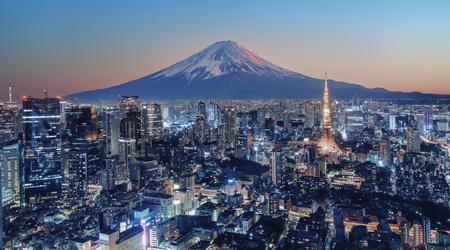
Photo: Tokyo Japan
Set sail on an extraordinary adventure through the islands Japan and South Korea, where history, culture, and natural beauty come together in perfect harmony. From the tranquil cedar forests of Yakushima to the vibrant streets of Tokyo, each destination offers a new and fascinating experience.
- Explore the best of Tokyo
- Immerse yourself in ancient Korean history and Buddhist culture in Gyeongju
- Discover the wonders of Yakushima Island
- Tour Nagasaki’s historic landmarks
- Experience Hagi’s Samurai history and pottery tradition
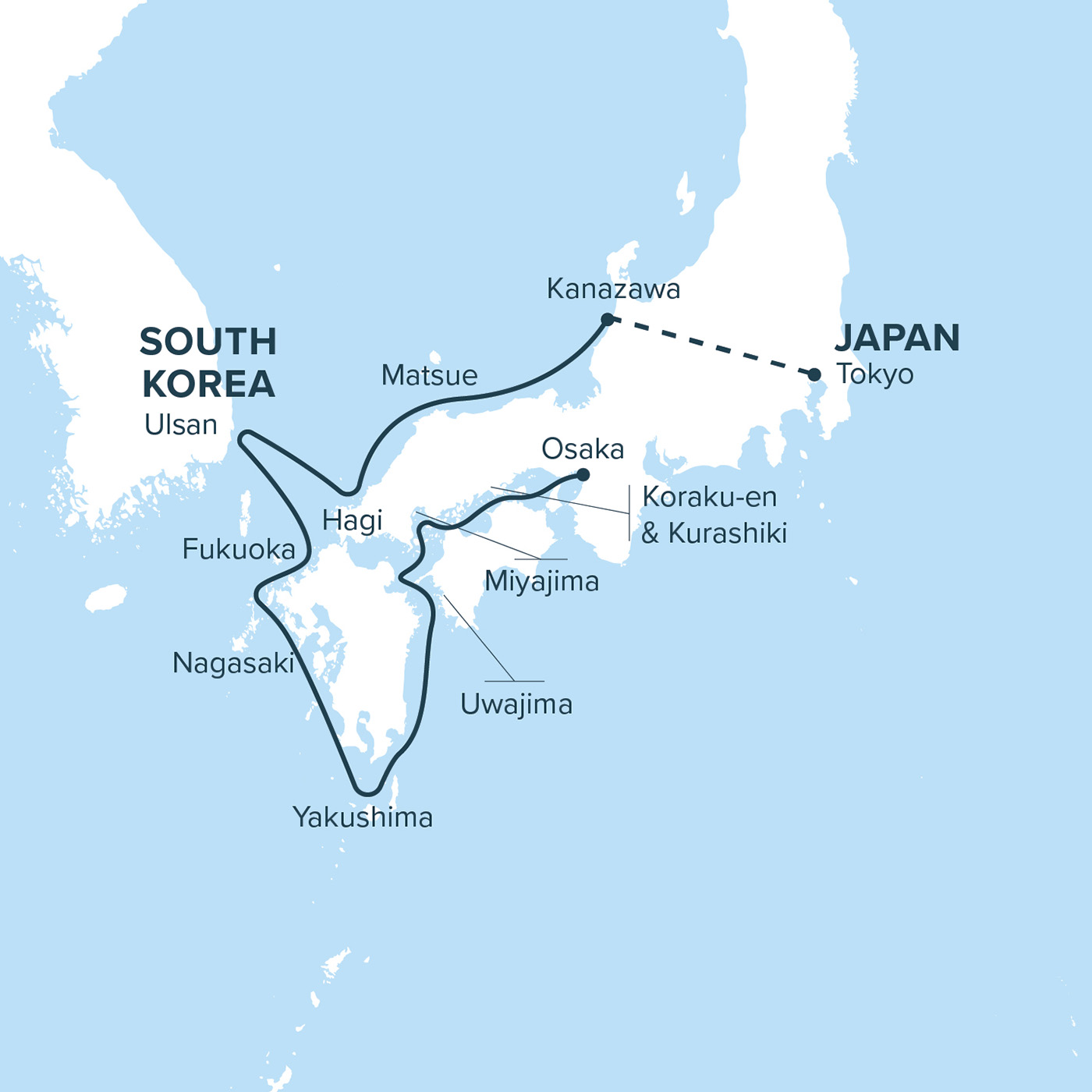
ITINERARY
Please note, that the itinerary below is for the May 4,
2025 departure. The April 24, 2025 departure runs in reverse order.
Day 1: Tokyo,
Japan
The Adventure Begins
Welcome to Tokyo, Japan’s famed neon-lit capital, Tokyo, where tradition meets ultramodern as towering skyscrapers sit alongside ancient temples.
Upon independent arrival, check into the hotel, where you'll spend the night.
Over a welcome dinner, get to know your expedition guides and fellow travellers as you prepare for the exciting journey ahead.
Day 2: Tokyo/Kanazawa
Journey to Kanazawa and Board Heritage Adventurer
After breakfast at the hotel, travel by Shinkansen (Japanese bullet train) to Kanazawa.
In the afternoon, board Heritage Adventurer where your captain and expedition team await, ready to welcome you aboard as we set sail on the next chapter of your adventure.
Day 3: Kanazawa
Traverse Shirakawa-go's Unique Heritage and Kanazawa's Artistic Streets
Today offers a choice of fascinating explorations. Head into the remote mountains of the Shogawa River Valley to visit the UNESCO World Heritage Site of Shirakawa-go. Nestled within Hakusan National Park, this historic mountain settlement is renowned for its traditional Gassho-zukuri farmhouses, some over 250 years old. These distinctive homes, built to withstand heavy snowfall, offer a glimpse into the unique cultural traditions of the region. Alternatively, immerse yourself in the artistic heart of Kanazawa, a city celebrated for its rich cultural heritage. Discover exquisite Kutani-style pottery, lacquerware, and gold-leaf craftsmanship. Stroll through the cobblestone streets lined with craft galleries and elegant restaurants, or visit Kenrokuen Garden, one of Japan’s most iconic Edo-period gardens. Don’t miss a visit to Omicho Market, where vibrant stalls showcase everything from fresh flowers to local delicacies. In the evening, join the expedition team in the bridge, observation lounge or up on the observation deck as we sail.
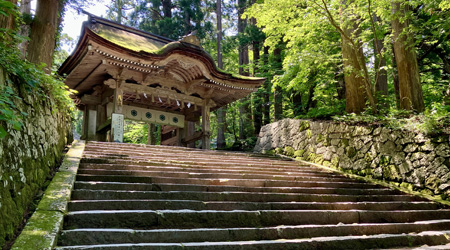
Photo: Matsue, Japan
Day 4: Matsue
Discover Matsue’s Castles, Gardens, and Cultural Delights
This morning, we arrive at the port of Sakaiminato, the gateway to Matsue, known as “the town of water” for its location between Lake Shinji and Lake Nakaumi. Visit Matsue Castle, a national treasure and one of Japan’s few remaining seventeenth-century castles that retain their original structure.
You’ll have several options to explore today. You might choose to wander through Daisen-Oki National Park, home to rare flora and fauna including the giant salamander. Alternatively, visit the picturesque Yuushien Garden, where the annual Peony Festival will be underway, or explore the Adachi Museum of Art, renowned for its stunning gardens and art collections.
For those interested in traditional crafts, a visit to Yakumo-mura village offers an opportunity to learn the art of Japanese paper making. Or, simply enjoy a leisurely stroll through Matsue’s charming streets and along its peaceful canals.
Day 5: Hagi
See Historical Sites and Traditional Pottery
Hagi began as a modest fishing port until Mori Terumoto fortified the town in 1604, with the Mori Samurai later playing a pivotal role in the mid-nineteenth-century anti-Tokugawa revolt. Today, Hagi is better known for its traditional pottery making.
Explore the Teramachi District’s temples and shrines, followed by a visit to the Jokamachi District, where you’ll walk among the old Samurai houses. Take time to visit Hagi Castle, Shizuki Park, and Tokoji Temple to further delve into the town’s rich history.
In the afternoon, journey to the Yoshika Taibi Memorial Museum, home to an impressive collection of Hagiyaki pottery, once highly prized in Edo-period tea ceremonies. Alternatively, you may choose to discover the natural beauty of the ancient Akiyoshido Cave, formed over 300 million years ago.
Day 6: Ulsan, South Korea
Explore South Korea’s Ancient Capital
Crossing the Sea of Japan, we arrive in Ulsan, South Korea, where we’ll head to the UNESCO World Heritage Site of Gyeongju. Once the capital of the Silla Dynasty, Gyeongju is often called "the museum without walls,” offering a rich tapestry of ancient Korean history and Buddhist culture.
Wander through a landscape dotted with ancient temples, tombs, and pagodas, and explore the treasures of the National Museum, from gold jewellery to intricate pottery. Along the way, savour traditional Korean delicacies and enjoy cultural performances that bring this historic city to life.
Day 7: Fukuoka, Japan
Experience Fukuoka’s Blend of History, Culture, and Modern Delights
Welcome to Fukuoka, Kyushu’s largest city, where history and modern life intertwine. Once two separate towns—Fukuoka, the castle town, and Hakata, the merchant hub—this lively metropolis offers a unique mix of traditional and contemporary experiences. Famous for its bustling yatai food stalls, highlighted by Lonely Planet and The New York Times, Fukuoka also boasts historic ruins, colourful coastal parks, and vibrant art installations.
During your time here, you may explore Kitakyushu to visit Kokura Castle, the TOTO Museum, or the beautiful Kawachi Wisteria Garden. Alternatively, take a trip to Nanzoin Temple to see its reclining bronze Buddha (thought to be the world’s largest bronze statue) and the Dazaifu Tenmangu Shrine surrounded by beautiful gardens, ponds, and bridges with more than 6,000 plum trees.
Day 8: Nagasaki
Journey through History and Resilience
In the morning, you’ll arrive in Nagasaki, a city shaped by both tragedy and renewal. Begin your day with a visit to the Peace Memorial Park and the Atomic Bomb Museum, solemn reminders of the events of World War II.
Step back in time to explore Dejima Island, built during the Edo period to house Portuguese missionaries and later Dutch traders, the only foreigners allowed in Japan during the Sakoku (solation) period. For 200 years, Dejima served as Japan's sole connection to the outside world.
As the port reopened to Westerners in the latter half of the nineteenth century, Nagasaki flourished as a vibrant international city. Many of the elegant stone and clapboard houses built for the new foreign residents remain today, preserved in Glover Garden. Among these historic residences is Glover House, the best-known Western-style residence built in 1863 and the setting for Puccini's opera Madame Butterfly.
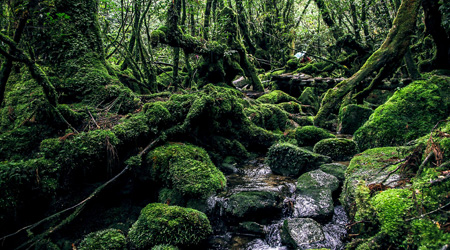
Photo: Yakushima, Japan’s first UNESCO World Heritage Site.
Day 9: Yakushima
Witness Ancient Cedar Trees and Diverse Flora
As we sail south to Kyushu, we reach the island of Yakushima, Japan’s first UNESCO World Heritage Site, recognized for its remarkable biodiversity.
Embark on your choice of nature walk through Yakusugi Land, part of Yakushima National Park. Here, you’ll encounter the island’s ancient cedar trees, including the awe-inspiring Buddha Sugi and Sennen Sugi, some over 3,000 years old. Keep an eye out for the endemic Yakushima macaque as you explore this enchanting forest filled with natural wonders.
Day 10: Uwajima
Learn about Pearl Cultivation in Uwajima
Visit the port of Uwajima on Shikoku Island, situated deep inside the saw-toothed coast of Uwajima Bay. Known as Japan’s largest pearl cultivation centre, Uwajima offers a unique opportunity to learn about the fascinating process of pearl farming, from implantation to harvest. Explore Uwajima Castle, perched on a hill with panoramic views of the town and harbour below. The afternoon is yours to enjoy at your leisure.
Day 11: Koraku-en and Kurashiki
Wander Through Japan’s Timeless Gardens and Historic Canals
Begin your day at the port of Uno-Ko with a visit to Koraku-en, one of Japan’s most famous gardens. This beautiful seventeenth-century landscape, known as the "garden of pleasure after," features twenty-eight acres of serene walking paths, ponds, and plum and cherry trees, creating a tranquil setting for exploration.
In the afternoon, travel to Kurashiki to explore its old merchant quarter. Stroll past seventeenth-century wooden warehouses painted white with traditional black tiles, along a canal framed with weeping willows and filled with koi. You’ll also have the chance to visit the Ohara Museum of Art, which showcases rare works by Matisse, Picasso, and Renoir along with collections from Japan’s Mingei movement.
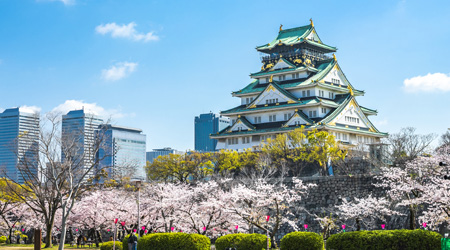
Photo: Osaka Castle, Japan
Day 12: Osaka, Japan
A Fond Farewell
Conclude your journey in Osaka, Honshu’s largest port city, where modern architecture and a vibrant dining scene are nestled alongside the sixteenth-century shogunate Osaka Castle. Disembarking Heritage Adventurer after breakfast, you may take the complimentary coach shuttle to a central hotel or the Kansai International Airport. To allow time for disembarkation procedures and travel from Osaka, we do not recommend booking flights departing before 1300 hours.
INCLUSIONS AND EXCLUSIONS
Included:
• Landing fees
• Pre-cruise bullet train transfer
• Post-cruise transfer
• hotel accommodation equivalent to on-board accommodation (includes dinner and breakfast)
• All on-board ship accommodation with meals
• House beer, wine, and soft drinks with lunch and dinner
• All shore excursions and activities
• Programme of lectures by noted naturalists
Excluded:
• All items of a personal nature
• Laundry
• Drinks
• Gratuities
• International flights
• Flights
• Visas
•Travel insurance


